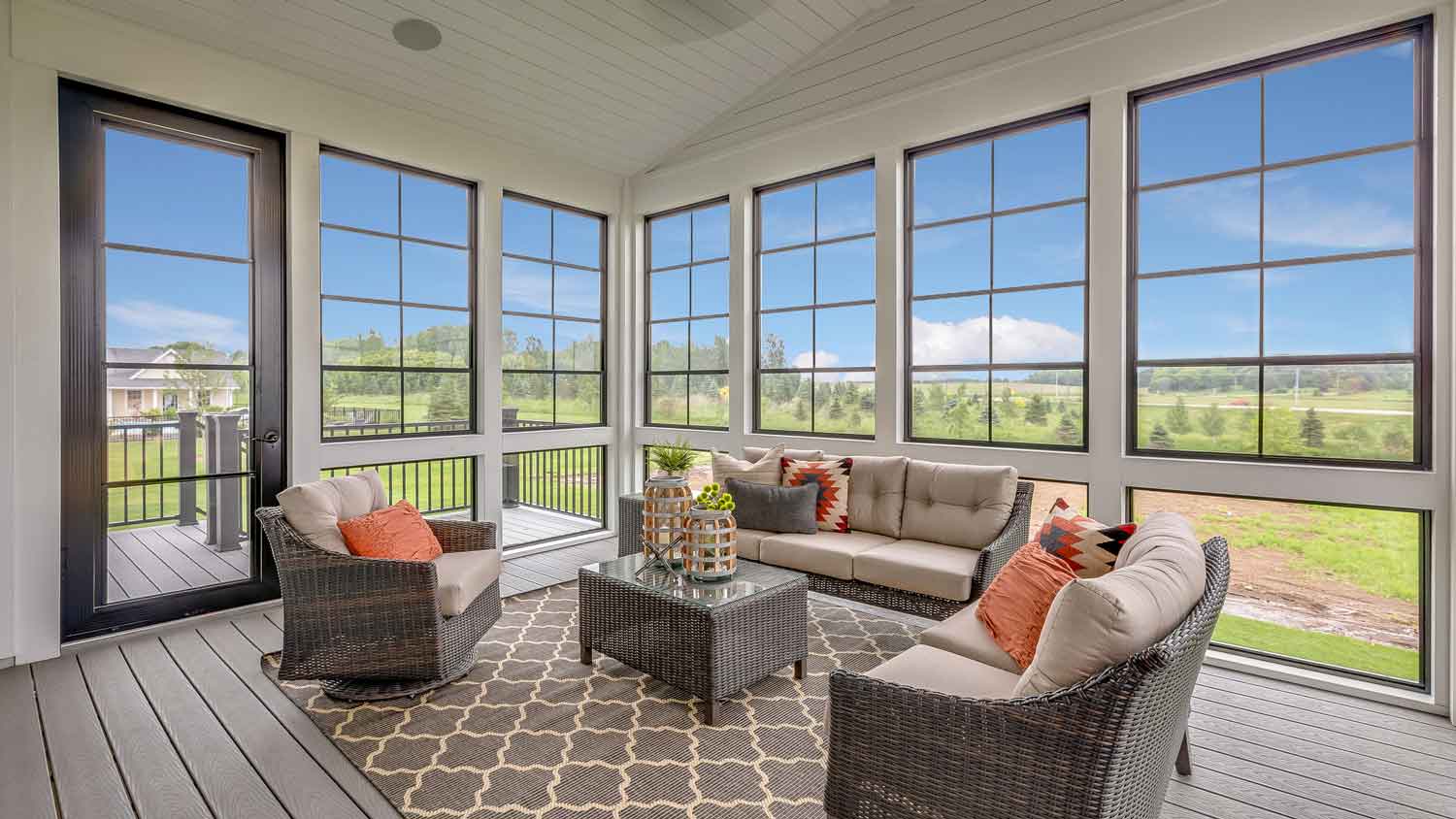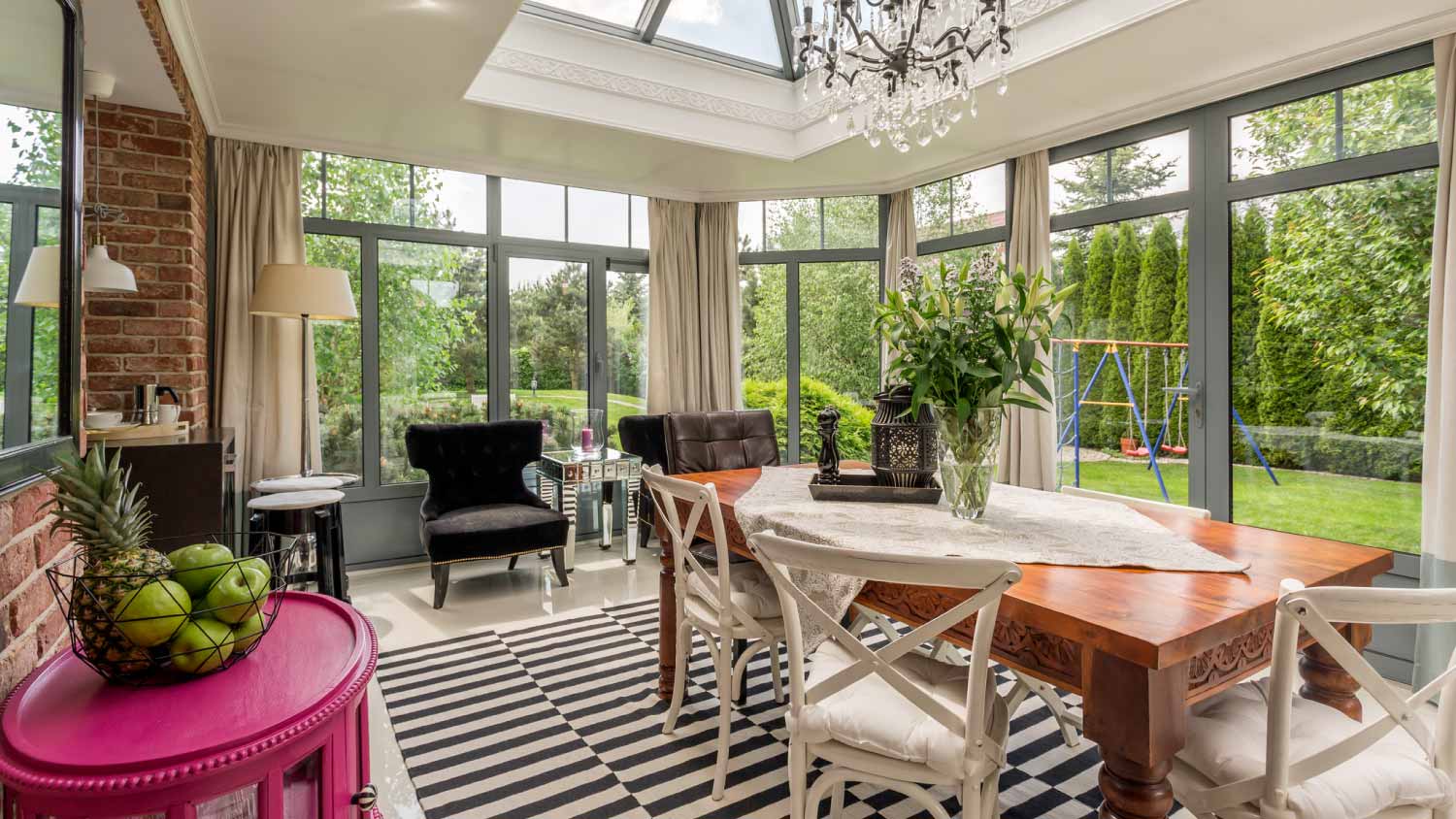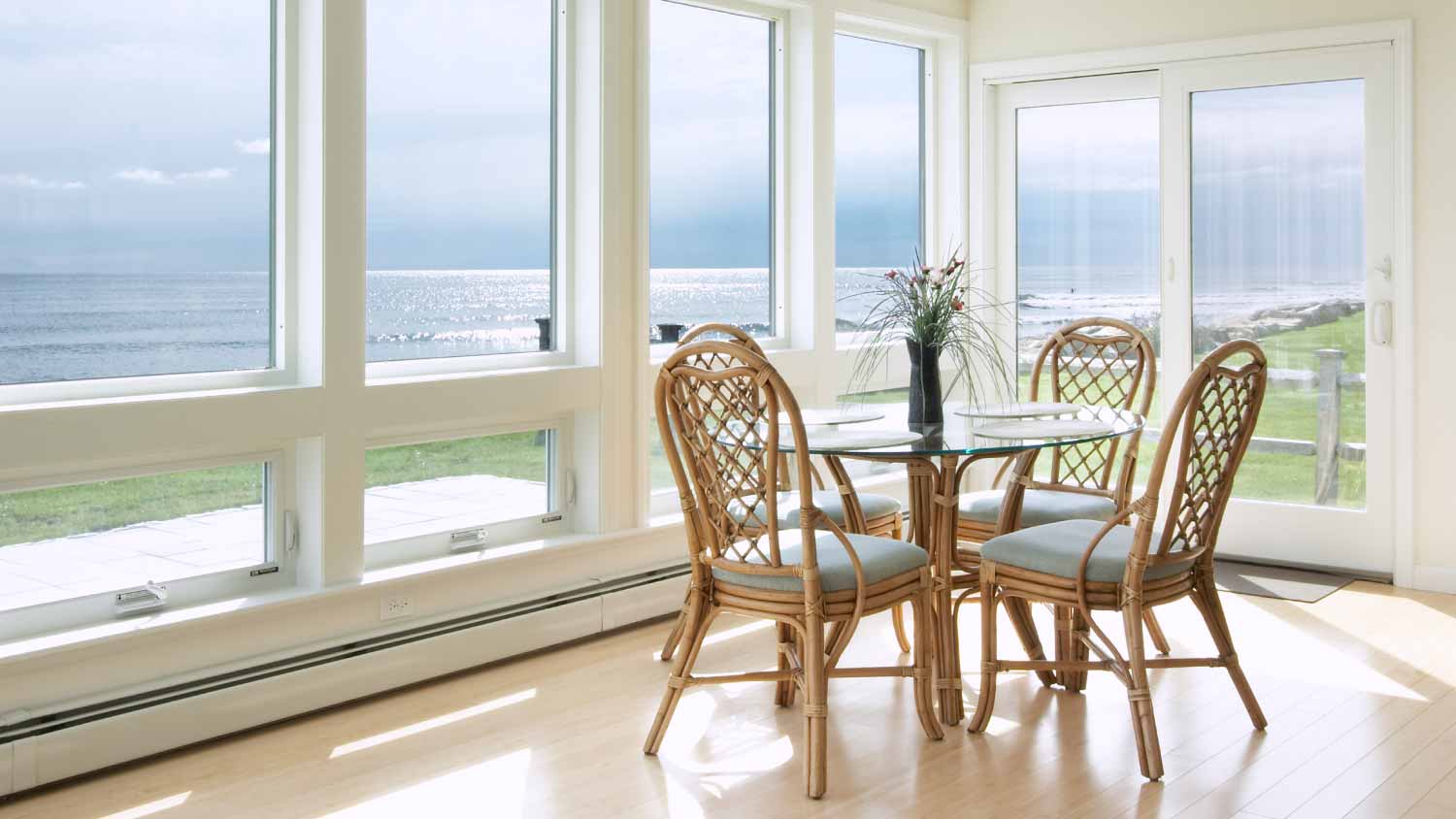
Considering adding a screened porch to your home? Discover the average cost of a screened-in porch, depending on its size, location, and more.
Bring in the sunlight and soak up the views


Sunrooms have less glass and are easier to clean and maintain.
Solariums offer more sunlight and unobstructed views.
Sunrooms can include electricity, heating, and cooling, while solariums don’t.
Sunrooms are normally more expensive, but some options are more affordable.
Many homeowners love the idea of having a room filled with natural light where the line between indoors and nature blurs. If you’re considering adding such a space to your home, deciding between a solarium vs. a sunroom can be tough. Both let in lots of sunshine, but there are some key differences between the two to consider before choosing.
A sunroom is a room with some standard walls fitted with screens or large windows (or sometimes, walls made entirely of glass) and a standard roof that matches the rest of your home. A solarium is made entirely of glass, including the walls and the roof, much like a greenhouse with a finished floor.
When taking on this project, expect questions only a pro can answer. With our network of local pros, you'll get the job done and your questions answered—without the hassle and stress of doing it yourself.

Sunrooms are a broad category of structures that include enclosed porches, screened-in rooms, solariums, conservatories, and three- and four-season rooms. Sunrooms usually have a standard roof and walls of glass or large windows and glass doors. They can be more rustic, as in the case of a greenhouse without a finished floor, or they can look and act just like a standard home addition but with more windows, as in the case of a four-season room, which has insulation, electricity, heating, and cooling.
Sunrooms can be more or less expensive than solariums depending on the type. Greenhouses and screened-in porches or Arizona rooms are more affordable, while four-season rooms are more expensive than solariums.
| Sunroom Pros | Sunroom Cons |
|---|---|
| More versatility | Less natural light |
| Can be insulated | Can be more costly |
| Less maintenance | Varying ROI |
| Offers more privacy | Some restricted views |
Best for: Homeowners who want more customization options or a fully functional home addition for added living space
Sunrooms cost less than solariums in some cases, so if you’re looking for a budget-friendly home addition, some types of sunrooms will be a better fit than a solarium. Speaking of the types of sunrooms, you have far more options than if you lock yourself into a solarium. You can go with a more rustic greenhouse, an all-glass solarium or conservatory, an airy Arizona room, or a more functional three-season or four-season room.
Four-season rooms, in particular, offer more utility because they’re insulated, heated, and often cooled. You’ll be able to use them year-round regardless of the climate, whereas a solarium will be too cold to enjoy during the winter months.
Most types of sunrooms are easier to maintain than a solarium because there’s less glass to clean. The walls or half-walls that take the place of some of the glass in a solarium offer a greater sense of privacy, too, so some types of sunrooms are a better fit if you have nearby neighbors.
Sunrooms can come with some downsides, too. Most notably, many types of sunrooms let in less light than all-glass solariums. Screened-in porches, three-season rooms, and four-season rooms have half-walls or sections of full wall that block light, and the roof isn’t made of glass, which limits sunlight, too. For the same reasons, you’ll have less wide-open views of the outdoors while you’re in a sunroom.
The ROI you’ll see from a sunroom addition varies widely, depending on the type, and some options are more expensive than solariums.

Solariums are a type of sunroom that’s made entirely of glass, including the walls and the roof, so it’s similar to a greenhouse, but it has a finished floor. Solariums let in maximum sunlight, and the windows and doors can be operational to allow for natural ventilation, too. Due to the all-glass construction, solariums rarely have electricity and aren’t insulated, heated, or cooled.
| Solarium Pros | Solarium Cons |
|---|---|
| Maximum sunlight | Can be more costly |
| Luxurious | Less privacy |
| Better for gardening | No temperature control |
| Unobstructed views | Requires more maintenance |
Best for: Homeowners looking for extra sunlight and a more luxurious place to relax where privacy isn’t a concern
Solariums are made entirely of glass, so they offer nearly unobstructed views of the outdoors and let maximum sunlight in. As such, they provide an ideal space for gardening and displaying plants.
Solariums look a bit more luxurious than most types of sunrooms, so they can add more value to your home than a greenhouse or screened-in porch.
Solariums require more maintenance because you’ll need to clean the glass panels inside and out, including the less accessible ones that make up the roof.
Solariums are more expensive than some types of sunrooms, including Arizona rooms and even some three-season rooms. Despite the higher cost, they have less utility, as it’s hard to run electricity through the all-glass walls, and you can’t efficiently heat or cool them for use during excessively hot or cold temperatures.
Finally, the all-glass construction that maximizes sunlight and views means less privacy for you while you’re lounging.

As you decide between a sunroom vs. a solarium, carefully consider how and when you’ll use the space. Factors such as energy efficiency and ease of maintenance will likely sway your decision.
The glass walls and ceiling of a solarium let you view the stars and landscape with little to no obstruction. Sunrooms offer a better view than a standard room, but they can’t compete with the immersive experience of a solarium.
Maintenance goes up the more windows there are to clean. Solariums are primarily glass, so you could spend considerable time washing the interior and exterior, including the glass roof, which can be tough to access. Sunrooms may have large windows that require more cleaning than a standard room, but they’re still lower maintenance than solariums.
Solariums aren’t heated or cooled, and they don’t normally have electricity run to them. Using a solarium won’t increase your utility costs. Some types of sunrooms are similar, like screened-in porches and conservatories, but three-season and four-season rooms will use electricity.
Depending on the size of your sunroom, standard sunrooms cost between $20,800 and $72,000 on average, while solariums cost $30,000 to $75,000. Some types of sunrooms are more affordable, but other types are more expensive. It’s best to compare the cost of the particular type of sunroom you’re considering to the cost of a solarium to compare more accurately.
You can buy prefab kits for sunrooms and solariums, making them a potential DIY project if you have some building experience. You’ll need to ensure you have all permits and the know-how to protect the existing structure if you’re adding to your house. You may want to hire a local sunroom pro to protect the value of your investment, but that’s the case with both sunrooms and solariums. A professional who builds sunrooms also gives you more options for your space, including customizations and features like electrical connections, heating, cooling, and more.
Sunrooms offer more utility than solariums for two reasons. First, you can add electricity to certain types of sunrooms to make them feel more like traditional living spaces. Second, you can insulate, heat, and cool sunrooms, which means you can use them year-round. Solariums are too cold to enjoy during the winter months, and the trapped solar heat can be too hot at the peak of the summer.
All types of sunrooms can add value to your home, including solariums, but you have the potential for a higher ROI if you build a four-season room that adds to your legal living space and square footage.
How do you want to use your space? A sunroom with adequate insulation could provide year-round use as a sunny dining or lounge area. Solariums offer the best views if you want to feel at one with nature without being exposed to weather and insects. Ultimately, you should pick your sunny escape based on your budget and lifestyle.
From average costs to expert advice, get all the answers you need to get your job done.

Considering adding a screened porch to your home? Discover the average cost of a screened-in porch, depending on its size, location, and more.

Homeowners can enclose their porches in a few different ways—each having their own price tag. Learn what contributes to the total cost to enclose a porch and how you can reduce the bill.

Use our expert guide to figure out how much it costs to install a pool enclosure. Establish your budget, then plan your pool enclosure project.

What are the types of screens for porches you can choose from to take your humble abode to the next level? And what makes each of them unique? Find out here.

Installing a sunroom on your home can boost value and add utility. Learn about the different types of sunrooms to get the most out of your home addition.

Dreaming of lounging in a sunroom but not sure how big it should be? Here’s everything you need to know about sunroom sizes and how to choose.